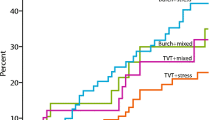Abstract
Tension-free vaginal tape (TVT) is a well established surgical procedure for the treatment of female urinary stress incontinence. The operation, described by Ulmsten in1995, is based on a midurethral Prolene tape support. TVT is accepted as an easy-to-learn and safe, minimally invasive surgical technique. Postoperative genital prolapse has been described following the Burch technique, as well as other surgical methods for the correction of female stress urinary incontinence. The aim of this analysis was to evaluate the occurrence of this specific complication in relation to TVT. Of 314 patients undergoing TVT and followed for up to 50 months only 1 suffered genital prolapse, with de novo grade 2 cystocele, rectocele and uterine prolapse, diagnosed 3 months after the operation. This is the first reported case of genital prolapse following TVT.
Similar content being viewed by others
Abbreviations
- TVT:
-
tension-free vaginal tape
References
Nilsson CG, Kuuva N, Falconer C et al. (2001) Long-term results of the tension-free vaginal tape (TVT) procedure for surgical treatment of female stress urinary incontinence. Int Urogynecol J (Suppl 2):S5–S8
Demirci F, Yucel O, Eren S et al. (2001) Long-term results of Burch colposuspension. Gynecol Obstet Invest 51:243–247
Kjolhede P, Ryden G (1997) Clinical and urodynamic characteristics of women with recurrent urinary incontinence after Burch colposuspension. Acta Obstet Gynecol Scand 76:461–467
Enzelsberger H, Helmer H, Schattern C (1996) Comparison of Burch and lyodura sling procedures for repair of unsuccessful incontinence surgery. Obstet Gynecol 88:251–256
Kiilholma P, Makinen J, Chancellor MB et al. (1993) Modified Burch colposuspension for stress urinary incontinence in females. Surg Gynecol Obstet 176:111–115
Neuman M, Lavie O, Gdansky E et al. (1995) Early uterine prolapse following colponeedle suspension. Aust NZ J Obstet Gynaecol 35:339–340
Author information
Authors and Affiliations
Corresponding author
Additional information
Editorial Comment: This report is the first of its kind. TVT has been around for several years. Knowing the incidence of post-TVT prolapse is important: such information will allow us to compare this procedure with other incontinence procedures. This study, however, is limited by its low numbers, only 255 patients being reviewed. Given an incidence of prolapse of less than 5%, 255 patients might not be enough to verify the true incidence of post-TVT prolapse. However, this article is very important and represents a beginning to the documentation of TVT.
Rights and permissions
About this article
Cite this article
Neuman, M. Low incidence of post-TVT genital prolapse. Int Urogynecol J 14, 191–192 (2003). https://doi.org/10.1007/s00192-002-1031-2
Received:
Accepted:
Published:
Issue Date:
DOI: https://doi.org/10.1007/s00192-002-1031-2




